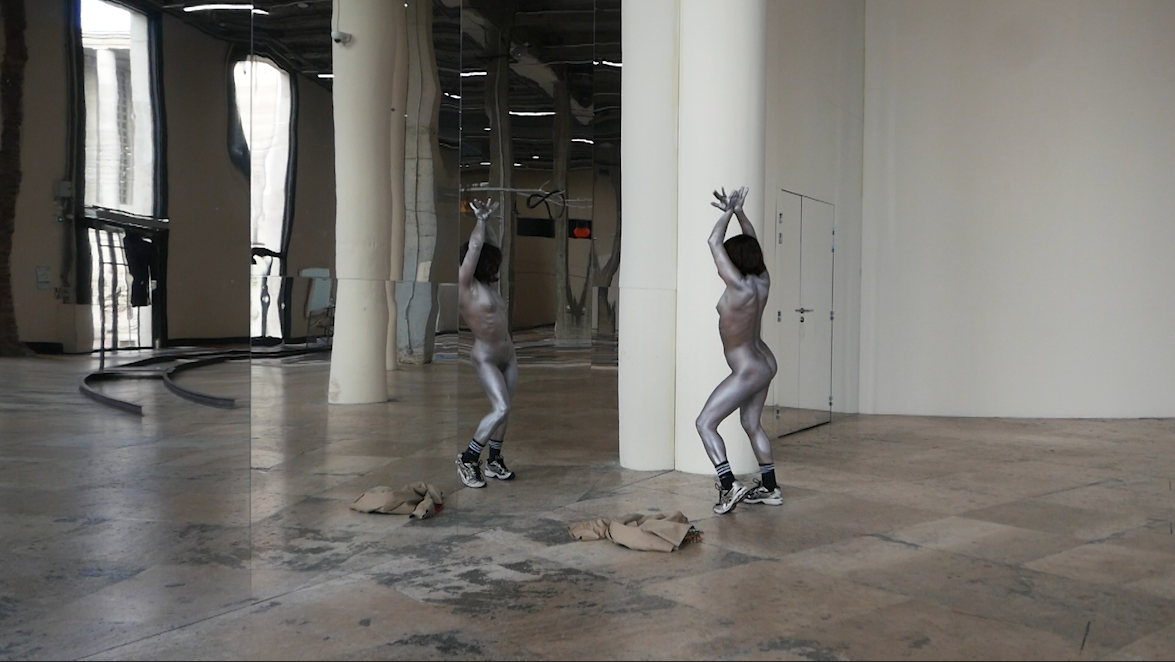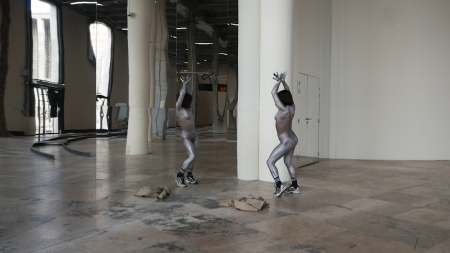
For the past 12 years, Lili Reynaud-Dewar has created works with a simple but reliable formula: she strips down, paints her entire body in a single color, and dances around museums when the public isn’t present.
Her choreography is jerky, at times even awkward—she initially took inspiration from the dancer Josephine Baker, then found the racial dynamics of a white artist drawing on a Black artist’s work too fraught and went in other directions. No matter whether she’s performing in the Arsenale of the Venice Biennale or the glassy lobby gallery of New York’s New Museum, these dances, which she documents via video, remain addictive to watch. Her latest gyrations, done at the Palais de Tokyo, will appear at that Paris museum this week in a new solo show.
But, ahead of that show, talking by Zoom from a sunlit terrace in Paris, Reynaud-Dewar seemed to express some exasperation about these works. “Maybe now it’s time to stop,” she said with a half-smile. “At some point, and maybe now even more, I liked the idea of exertion, not only of the body, but of the work—you know, if you repeat it over and over, museum after museum, always using the same limited repertoire. Maybe it exhausts itself.”
The dance performances have become a calling card for Reynaud-Dewar, whose work won the Prix Marcel Duchamp, France’s highest art award, two years ago. Yet the Palais de Tokyo show will encapsulate how Reynaud-Dewar’s practice is far more expansive than these videos, which are just one part of her quest to bring all things private into the public eye.
A core component of the show will be a text piece drawn from Reynaud-Dewar’s diaries from 2022. The entries range from the banal to the epic, from the color of a person’s shoes to the very state of France, the country Reynaud-Dewar calls home, at a given moment in time.
“I’m very interested in keeping memory and being a witness,” she said. “For me, what’s interesting here is that I’m being both a witness to my own life and to my own environment and society. I’m commenting a lot on the news, what’s happening in the political context in France. I’m a witness, a performer, and an artist.”
Reynaud-Dewar, who that day was wearing a denim shirt with flaps that fell open at its armpits, spoke with the same disarming honesty that will recur throughout this diary. She held a blue e-cigarette—a similar one can sometimes be seen during moments in the dance videos when she isn’t performing—but she never took a puff from it. One might not expect such modesty from a premier French artist about to open a major institutional show in one of the country’s top contemporary art museums.
The Palais de Tokyo show is in some ways the culmination of years of work by Reynaud-Dewar. Since she started exhibiting her art two decades ago, she has taken up subjects ranging from wearing gold grills as a form of cultural appropriation to the writings of Guillaume Dustan, a gay writer whose sexually liberated novels included descriptions of unsafe sex, leading him to be decried by ACT UP. Time and again, she has considered how individuals relate to society more broadly, quoting liberally from thinkers who viewed themselves as outsiders.

Sometimes, her art is a collective endeavor. (The Palais de Tokyo show’s title, after all, is “HELLO, MY NAME IS LILI AND WE ARE MANY.”) She frequently works with her students at Geneva’s Haute École d’Art et de Design, turning her classes there into think tanks that ultimately result in artworks. Reynaud-Dewar views these students as authors in their own right; she’s brought them in as her peers for the Palais de Tokyo show. “It’s very important that [their] work is not signed by me,” she said. “As a student, you’re not supposed to stay forever in the school where you’re a student, so in the collective, people come and go.” With a quiet laugh, she noted, “I’m the professor, the only one who stays somehow.”
She said she tried to even push the Palais de Tokyo curators to mount two separate exhibitions—one for works where she is credited solo, the other for these collaborative pieces—but she didn’t entirely get away with it. Still, new works by the students’ group, Gruppo Petrolio, will be well-represented.

Gruppo Petrolio is a reference to the Italian filmmaker Pier Paolo Pasolini’s novel Petrolio. Written between 1972 and 1974, and left unfinished at the time he was murdered in 1975, Petrolio follows two protagonists, both named Carlo, who may or may not be the same person. One is a wealthy Catholic leftist who works for a state-run oil company; one lives in poverty in Rome. Both have sexual proclivities that push against the accepted norms of the bourgeois.
“Petrolio is super, super complicated,” Reynaud-Dewar said. “My students were like, ‘We don’t understand anything, you have to give us a proper class.’” Unusually for her, to help elucidate the book’s allusions to leftism and fascism in postwar Italy, she lectured on activists of the era who fell on both sides of the political era, temporarily turning her class into an academic crash course instead of a seminarconsidering the merits of a given work. She’d planned for the students to visit Rome afterward, so they could read excerpts from Petrolio in places where it is set. But once the pandemic set in, she had to rearrange her plans.
Instead, much later on, they ended up traveling two hours south of Geneva, to Grenoble, the French tech hub where Reynaud-Dewar lives and works. There, they pondered subjects such as gentrification, ecocide, and cities as living environments.
This is a mode of teaching that is quite different from the traditional art-school one, which typicallyinvolves students visiting biennials and debating the works on view. But Reynaud-Dewar said that “it was super interesting to not be art nerds and move our interests elsewhere.”
What has resulted looks only a bit more traditional: a video installation featuring 19 hours’ worth of footage that recounts the final days of Pasolini. (Given its length, this work will be available to the public in a gallery without admission fees, with the hope that some will return to view it in full.) The filmmaker Abel Ferrara attempted something vaguely similar with his 2014 biopic starring Willem Dafoe as Pasolini. Reynaud-Dewar had her students watch the Ferrara film, which she called “an American take” on a very European subject, but their approach is quite different.


The footage includes the students reading Pasolini’s words, essentially performing as him. Some of the material is scripted, while other scenes, showing the students debating what kind of film they want to even make, are not. The film proposes that there is no one way to monumentalize a figure so mythologized as Pasolini, instead arguing that the best means of paying homage to him is to study his politics, which provocatively use sadism and subversion as a means to undermine the status quo. Reynaud-Dewar said she wants Pasolini’s calls to action—and Gruppo Petrolio’s art—to be “contagious.”
“Another collective will do it, and another collective will do it,” Reynaud-Dewar said, noting that recent protests at museums against the climate crisis might owe something to Pasolini’s own leftist activism. “It becomes very big.”
Alongside these films will be others by Reynaud-Dewar, who, for one solo project, interviewed men who inhabited a Paris hotel, where they spoke about notions of property and ownership. Acting as an interviewer and perhaps an interlocutor,Reynaud-Dewar hovers somewhere off-screen as the focus is instead placed on these male residents, who are allowed to spout off for nearly an hour at a time in rooms lit shades of red.
She said she believes the connecting thread between these works and the Gruppo Petrolio ones is the gender of her interviewees and Pasolini. “Maybe it’s too pretentious,” she mused, “but maybe it’s an investigation into masculinity. There were a lot of questions around private property and how these people organize their lives and their rented space, and their position on this.”
Their answers are rarely clear-cut. Queried about masculinity, one male sex worker, in a prior work exhibited last year at Vienna’s Layr gallery, told Reynaud-Dewar that he appreciates “states where you triumph over your own body” before mentioning that he and his friends aim to reach a place in which “identity is not at all fixed.”
Then she took a step back, saying that she believed the hotel works may not be so relevant in the years to come, when AirBnBs take over. Perhaps someone in 2050 wouldn’t get it. She hoped the Palais de Tokyo show had “sociological interest,” she said, before humbly adding, “I think the work is maybe not that good as, you know, a contemporary art piece. But as a document of its time? Maybe.”
With Minimal Representation from the Global South, Paris+ Considers Its Selection Process in Second Edition
A Stunning Mark Rothko Retrospective in Paris Illuminates the Artist’s Lesser-Known Sides

Comcast’s CEO Just Snagged a $9 Million Penthouse at One of L.A.’s Most Exclusive Buildings

The Foggy Future of Farfetch

I’m dumping my iPad Air for the iPad mini

Max Verstappen Seeks 50th F1 Win at U.S. Grand Prix in Austin


